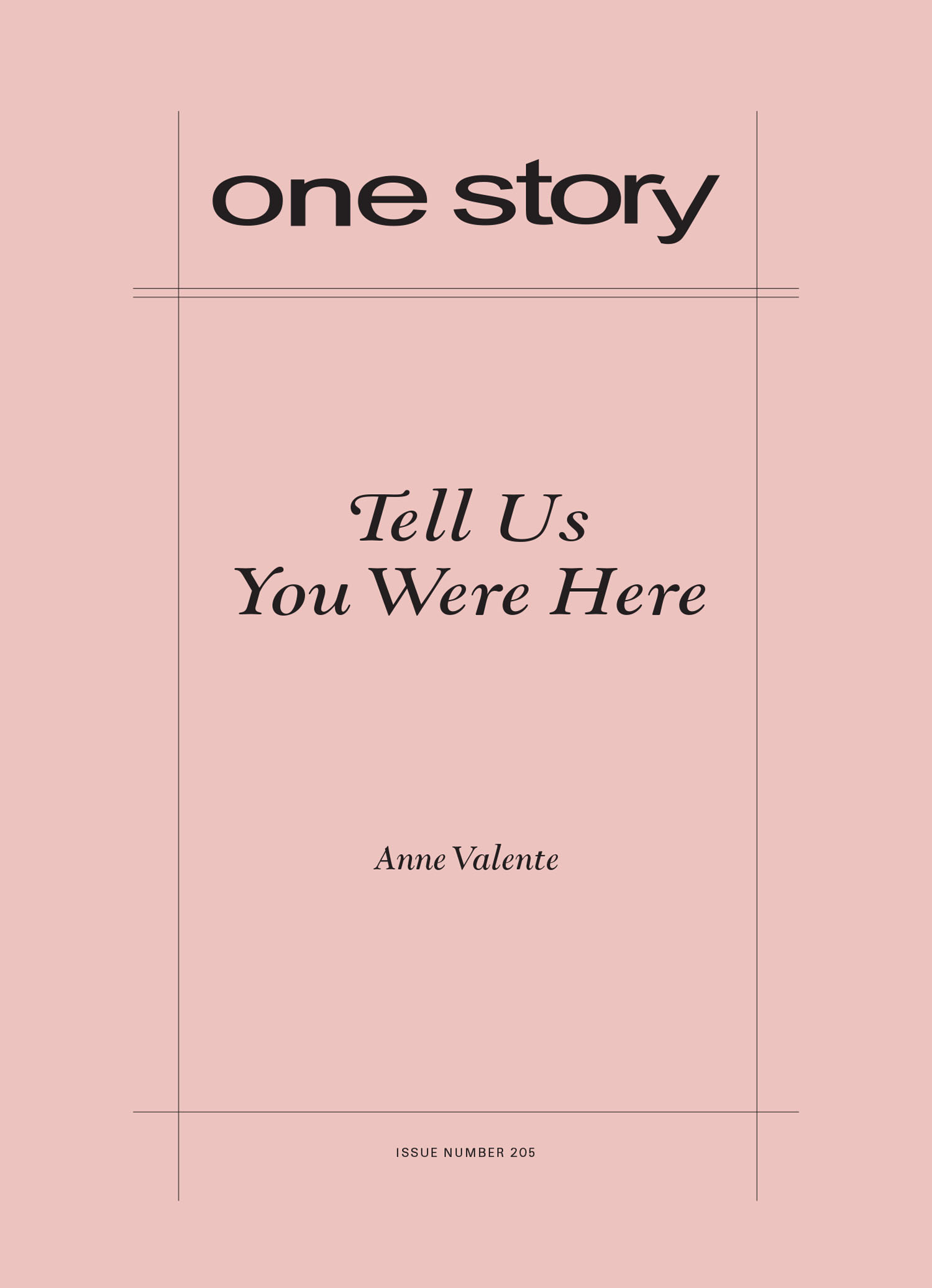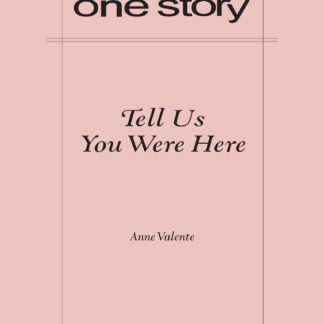
Tell Us You Were Here
$2.50
55 in stock
Excerpt
We fan out across the floorboards. Swelled wood. The damp scent of mold, a wet wash of intermittent rain. A pale moon leaking through the panes of warped attic windows, their curves breaking the moonlight into shards. We slide down against the walls. We crouch beneath a vaulted ceiling. We strain to hear the voice of a ghost, the same voice Pearl Curran heard a century ago in this house.
Anne Valente
Anne Valente is the author of the short story collection, By Light We Knew Our Names (Dzanc Books, 2014), and the forthcoming debut novel, Our Hearts Will Burn Us Down (William Morrow/HarperCollins, 2016). Her fiction appears in Ninth Letter, The Normal School and Hayden’s Ferry Review, among others, and her essays appear in The Believer and The Washington Post.
Karen Friedman on “Tell Us You Were Here”
Do you have a ghost story? I do. One night, when I was eighteen years old and crying in bed, the springs of my mattress compressed beside me and a hand touched my leg. This contact was the culmination of months of eerie activity in my room – mostly missing items suddenly reappearing and unexpected noises. Senior year had been rough. Within one week, my grandfather died and my parents announced their divorce. The ghostly hand on my leg was not menacing, but somehow caring. It freaked me out.
Our latest issue, “Tell Us You Were Here” by Anne Valente is all about ghosts and what beliefs become necessary for a person to survive. The story centers on an unlikely trio of women ghost hunters, each with her own reason for searching out proof of the unknown, each damaged in her own way. The women seek a ghost named Patience Worth, who in the early part of the 20th Century supposedly penned novels and plays through the medium (and actual historic figure) Pearl Curran.
The narrator, a non-believer and a geologist by training, has recently fled her adult life and returned home to St. Louis. She is working at a coffee shop by day and getting stoned in her parents’ basement every night. Anne expertly interweaves fact and fantasy, the narrator’s concrete knowledge of geography with a spiritual search in which proof is often elusive.
My daughter, too, looks for proof about the things she loves, but fears may not be real. Like Narnia. Or the Tooth Fairy. We’re careful to walk the line between honesty and her imagination. My practical side recognizes the flimsiness of my superstitions. But belief in a little everyday magic has made my life richer, given me strength, even been a comforting hand at a time when I needed it. So when my daughter asks, I paraphrase the old line about there being more things between heaven and earth than we can imagine. I hope, like the narrator in “Tell Us You Were Here”, that even in the face of overwhelming reason, the chance of what might be possible is enough.
For more on Anne’s historical inspiration and how her story developed, please visit our author Q&A. We hope to see you on May 15th in Brooklyn, where we’ll be celebrating Anne as one of our literary debutantes at the One Story Literary Debutante Ball. Get your tickets today!
Q&A by Karen Friedman
- KF: Pearl Curran was a real person. Can you talk a little about when you first heard her story and what about it intrigued you?
- AV: Washington University in St. Louis has a fascinating podcast, Hold That Thought, which is similar in style to Radiolab but focuses on faculty research. I’ve been following the podcast for awhile because I’ve been writing a lot about St. Louis, and because the show’s editor and producer is Rebecca King, who also serves as editor of Origami Zoo Press. I give her full credit for introducing me to Pearl through her amazing work on Hold That Thought. Just before Halloween of 2013, Pearl Curran was featured on the podcast because Daniel Shea, an English professor at Washington University, wrote a book about her and has studied her extensively. After hearing the podcast, I was completely hooked. I’d been gravitating toward oddities in St. Louis’s past for my fiction, and the history of Pearl Curran and Patience Worth is just so strange and wonderful. Having grown up in St. Louis, I couldn’t believe I’d never heard about them before. After listening to the podcast, I fell down a rabbit hole of researching their story.
- KF: Pearl’s story is really just a foil, though, for the narrator’s struggle with belief. Did any incarnation of this story center on Pearl, or did you always know that you were coming at it from a modern view?
- AV: I think I always knew I’d come at it from a modern, contemporary perspective. I’ve been trying to find a good reason to write about ghost hunters and paranormal societies for awhile – every place I visit, I seem to seek out ghost tours – and as soon as I learned about Pearl, I knew this was my chance. I seek them out because they’re excellent tours of history for any location, but I’m also fascinated by those few on each tour who aren’t tourists and who have extensive equipment, stories, and logs of charted paranormal activity. I’m interested in the science of their investigations and how they came to believe.
- KF: So do you believe in ghosts?
- AV: I really don’t know. I do know that beyond everything that’s so interesting about paranormal investigators, I seek out ghost tours because I’m also looking for evidence to believe. Which is exactly the opposite of belief, it seems – ghosts require a leap of faith, and yet the approach through paranormal investigation is data, meters, readings. I think my beliefs take residence somewhere within this paradox: of intuiting that there are things we can’t know but trust are there, and the hard science of evidence and how interesting that evidence can be. I love the notion of walking through a historically haunted place and just knowing a presence is there, as much as I love knowing how EVP recorders work and what dowsing rods are detecting.
- KF: What was the most challenging aspect of writing this story?
- AV: The hardest part was balancing the historical background with the contemporary, present story. I wanted readers to know who Pearl Curran and Patience Worth were, but I didn’t want to lose the Mid-American Paranormal Society and their investigation to the weight of backstory. It was a challenge to balance such an extensive history between Pearl and Patience with the concerns of Tessa, Alice, and the narrator’s struggle with belief.
- KF: You and I are both from St. Louis, and in fact, your story is set there as well. I feel compelled to ask you something about regionalism and writing. Do you think of yourself as a Midwestern writer and if so, what does that actually mean to you?
- AV: I do and I don’t think of myself as a Midwestern writer. In the past three years, I’ve been writing almost exclusively about St. Louis through a novel that is set there, as well as short stories about St. Louis history that I’ve been writing to take breaks from the novel. Setting has become extremely important, and by extension, a strong sense of Midwestern – and specifically, St. Louis – landscape and environment. With that said, up until three years ago, I never thought to write about St. Louis. It felt too close. And I anticipate moving on from the city in the coming months too, in terms of what I’m writing. But regardless of whether I do or don’t write about the Midwest, I do think that regionalism in writing may have something to do with soundscape for me – what acoustics I grew up with, whether that’s bird songs or traffic or patterns of wind, and how that burrows into my language. In other words, whether I’m writing about St. Louis or St. Lucia or St. Paul, my birthplace influences my sense of sound and rhythm.
- KF: What are you working on now?
- AV: I recently finished a novel and am in the process of completing a short story collection on the city of St. Louis and its history. I have just a couple of stories left to write, and they’ve gravitated toward blending city history with magic realism, natural science, and an emphasis on Missouri’s flora and fauna.
- KF: What is the best bit of advice about writing you have ever received?
- AV: During my MFA program at Bowling Green State University, Wendell Mayo told me that he knows a story is done when the hair stands up on the back of his neck. As a tinkerer of endings and getting those last lines right, I think this advice really resonated with me. I don’t get goosebumps, but I do feel viscerally flooded when I know I’ve found the right words to end a story. Wendell’s advice helped me trust my gut with the use of language, and with paying attention to the way words can move us.
